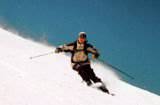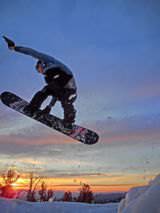Skiing and snowboarding are ways of moving over snow with boards attached to the feet; practiced mostly as recreation or sport, but often as conveyance.
Skiing is a kind of sport that uses a pair of skis to travel over snow. The skis are bound to boots, and progress is one foot at a time. On the other hand, snowboarding involves traveling on snow on a single snowboard attached to boots. Snowboarding is inspired by surfing, skiing and skateboarding.
Comparison chart
History & Evolution
Skiing was invented by prehistoric people (Samis, Nordic) mainly as means of transportation and for hunting. Documented evidence of origin of skiing is found in Norway and Sweden. The origin of skiing as recreation and sport is attributed to Sondre Norheim (Father of Modern Skiing). He is responsible for the creation of skiing templates and all modern versions of skiing have originated from this. Telemark skiing or telemarking was common in 19th century and has since then been revived. New technique called the snow plow or stem technique has made snow slopes friendlier to beginners. The Arlberg technique is largely responsible for making skiing a very popular recreational activity.
The snowboard is believed to have been developed in 1970s in Utah. The first snowboard was called the Snurfer and was designed by Sherman Poppen for his daughter in 1965. The Snurfer began to be manufactured as a toy from the following year. The 1970s and 1980s saw snowboarding evolving into a popular recreational sport. Dimitri Milovich developed snowboard designs and started his own company called WinterStick. Jake Burton Carpenter, Tom Sims, Chuck Barfoot and Mike Olson are largely responsible for the snowboards and mechanisms that is currently in used today.
Types & Styles
Skiing primarily consists is of two types:
Telemark Alpine or Downhill skiing
Apart from these there are many other types of skiing:
Freestyle skiing:
- Alpine freestyle – using aerial acrobatics and balance by rails (jibbing).
- Freestyle / Newschool – trick like twin tip, flips, spins etc are associated with this type of skiing.
- Freesking / Freeride – is doe on steeper slopes, cliffs etc. There is requirement for fatter skis.
Nordic skiing:
- Nordic skiing – also known as Cross Country skiing. Can be freestyle or classic. All techniques are allowed except skating techniques.
- Nordic jumping – also known as ski flying and ski jumping. Performed with Nordic style skis.
Military skiing - used as means of military transport apart from being enjoyed as recreation and sport. Army troops are trained for ski warfare which uses military skiing techniques. Biathlon, the sport owes its origin to military skiing patrols.
Kite skiing - skiing while being carried or pulled by kite, hang glider or parasail.
Paraskiing - done after jumping off from a plane or starting at high altitude.
Adaptive skiing – done by individuals with disabilities.
Dry slope skiing – done on artificial snow, dirt or dry snow.
Snowboarding is done in many styles which are used for recreational as well as in professional snowboarding.
- Jibbing and Rail riding – riders jump over rails and obstacles.
- Free riding – this is the most common and is easily accessible. It is simple riding down any terrain.
- Dry Slope – snowboarding over man made slopes for the purpose during summer or in places where there is no snow.
- Freestyle – rider uses manmade obstacles and terrain features to perform tricks and jumps.
- Free carve – is also known as alpine snowboarding. Riders ride over hard packed snow and the focus is on carving turns.
Techniques Used
Skiing, makes use of poles to assist skiers as they move downhill or uphill and support them when they are in an upright position. It is necessary for snowboard riders to frequently seat themselves and exert more energy to remain on edge when they are at a stop.
Both a snowboarder and a skier hold the same kind of expertise but with respect to sheer velocity, skiing gains an upper hand over snowboarding. Skiers are faster than snowboarders.
Effect on the body
Skiing relatively affects the knees more when compared to snowboarding. Injuries and accidents related to the knee and broken bones occur largely in skiing. Snowboarding is more harmful to the wrists.
Competition
Skiing competitions are organized by International Ski Federation and this body is responsible for rules and regulations, scheduling of competitions etc. each county has its own national association which manages the competitions. The US Ski and Snowboard Association handle competitive skiing in America.
The Air & Style, Burton Global Open Series, Shakedown, X-Trail Jam, X-Games are large snowboarding contests. The Ticket to Ride is the largest grand finale of all independent free style events under the Tour Flag. It is officially recognized as TTR.







 Mountain Bike
Mountain Bike  River Rafting
River Rafting  Freerunning
Freerunning  Scuba Diving
Scuba Diving  Rappelling
Rappelling  Hiking
Hiking
Comments: Skiing vs Snowboarding
Anonymous comments (4)